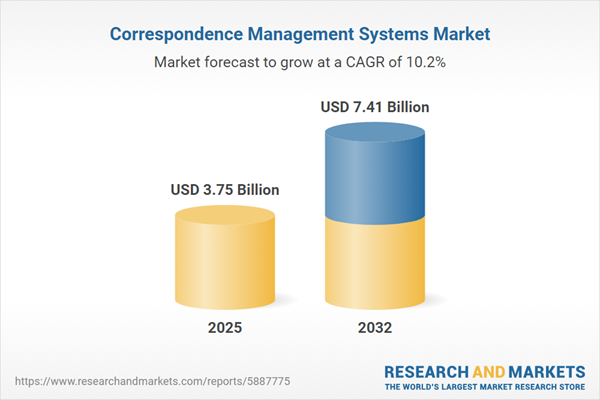Speak directly to the analyst to clarify any post sales queries you may have.
Correspondence management systems have become essential for enterprises aiming to strengthen their digital infrastructure, enabling secure, compliant, and streamlined communication processes at scale. As regulatory expectations rise and information flows grow more complex, these platforms serve as pivotal solutions for today’s business leaders.
Market Snapshot: Correspondence Management Systems Market
The correspondence management systems market is experiencing strong expansion, with global revenues projected to grow from USD 3.40 billion in 2024 to USD 3.75 billion in 2025, and forecasted to reach USD 7.41 billion by 2032. This sustained trajectory is driven by enterprise needs to enhance digital communication capabilities for critical business processes, particularly where compliance is essential. Industry leaders continue to accelerate innovation by integrating artificial intelligence, robust security frameworks, and cloud-native deployment options. These advancements equip organizations to efficiently meet changing compliance requirements, while streamlining internal workflow management and supporting secure document handling.
Scope & Segmentation: Comprehensive View of Correspondence Management Systems
- Component Types: Software platforms, managed services, professional support offerings, outsourcing models, and specialized technical assistance enable enterprises to tailor deployments for diverse operational and compliance needs.
- Organization Sizes: Solutions designed for both large enterprises and small to medium-sized businesses help address varying workflow complexities and governance demands.
- Industry Verticals: Financial services, banking, insurance, government, healthcare, telecommunications, ecommerce, and retail leverage correspondence management systems for improved regulatory compliance and operational efficiency.
- Regions: Adoption spans the Americas, Europe, Asia-Pacific, Middle East, and Africa, with a focus on local compliance, language preferences, and deployment approaches impacting vendor selection and implementation.
- Technologies: Key features include AI-powered workflow automation, end-to-end encryption, mobile functionality, seamless third-party integration, and flexible cloud frameworks that allow organizations to continually adapt to regulatory changes.
- Leading Companies: Providers such as OpenText Corporation, Adobe Inc., Oracle Corporation, IBM, Salesforce, SAP SE, Quadient SA, Pegasystems Inc., Pitney Bowes Inc., and Doxee S.p.A. deliver solutions that address the operational needs of a wide range of industries and use cases.
This segment diversity enables decision-makers to align platform selection with the scale, technical preferences, and regional obligations of their organizations, promoting value-driven, sustainable implementations.
Key Takeaways for Senior Decision-Makers
- Artificial intelligence–based automation reduces manual workloads and increases efficiency, supporting consistent communications across distributed teams.
- Cloud-based deployment models provide agility and scalability, helping enterprises manage variable regulatory and business requirements as they evolve.
- Integrated security features, including multifactor authentication and encryption, help safeguard sensitive content and support both internal and external standards compliance.
- Flexible customization for industry and regional requirements ensures adaptability amid ongoing changes in market and regulatory dynamics.
- Interoperability with enterprise software platforms, such as ERP and CRM, enhances process continuity and drives end-user adoption.
- Localization and analytics functionalities support proactive compliance management and help inform responses to emerging market trends and regulatory shifts.
Tariff Impact: Strategic Supply Chain and Operational Responses
Forthcoming U.S. tariffs may create new challenges for vendors relying on hardware-centric implementation models. In response, organizations are increasingly transitioning to software-based and hybrid cloud solutions, coupled with local sourcing strategies. These measures reduce potential disruptions in supply chains and regulatory exposure, maintaining continuous operational support for mission-critical communications.
Methodology & Data Sources
This report is based on interviews with industry executives, targeted surveys, and peer-reviewed academic research. Insights are supplemented by perspectives from regional subject-matter experts, and all data is cross-validated for accuracy and relevance to distributed and multinational enterprises.
Why This Report Matters
- Guides senior leaders in evaluating and selecting correspondence management systems that align with digital transformation objectives and compliance requirements.
- Offers actionable insights for technology selection and vendor strategy, tailored to organizational, sector, and geographic needs.
- Presents market-driven analysis to aid in strengthening communication resilience and comprehensive risk management strategies.
Conclusion
Correspondence management systems support organizations in delivering secure, compliant, and efficient communications. As digital business operations evolve, these platforms remain integral to achieving agility and regulatory alignment in enterprise environments.
Additional Product Information:
- Purchase of this report includes 1 year online access with quarterly updates.
- This report can be updated on request. Please contact our Customer Experience team using the Ask a Question widget on our website.
Table of Contents
3. Executive Summary
4. Market Overview
7. Cumulative Impact of Artificial Intelligence 2025
Companies Mentioned
The companies profiled in this Correspondence Management Systems market report include:- OpenText Corporation
- Adobe Inc.
- Oracle Corporation
- International Business Machines Corporation
- Salesforce, Inc.
- SAP SE
- Quadient SA
- Pegasystems Inc.
- Pitney Bowes Inc.
- Doxee S.p.A
Table Information
| Report Attribute | Details |
|---|---|
| No. of Pages | 196 |
| Published | October 2025 |
| Forecast Period | 2025 - 2032 |
| Estimated Market Value ( USD | $ 3.75 Billion |
| Forecasted Market Value ( USD | $ 7.41 Billion |
| Compound Annual Growth Rate | 10.2% |
| Regions Covered | Global |
| No. of Companies Mentioned | 11 |









